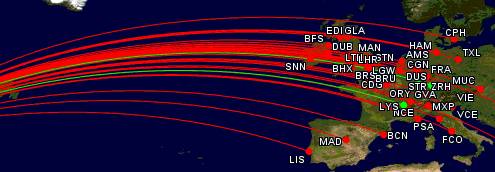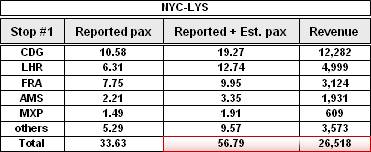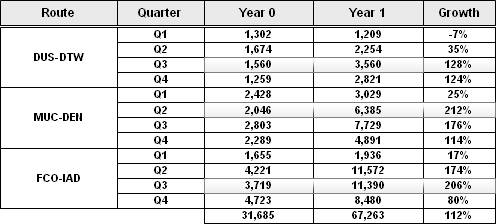In this scenario, an airline with an international hub in Newark, New Jersey, wants to identify new routes to Western Europe now possible through Open Skies.
The study is based on 2007 data (IATA BSP) with the support of PaxIS.
To spot potential routes, we first look at current activity in the region.
We search for direct routes from all of New York’s airports, including Newark, to all of Western Europe.
Two points of interest stand out. There are no direct routes from New York to Lyons, France or Stuttgart, Germany.
Lyons is France’s second-largest centre, moving approximately 7 million passengers through its airport annually.
The greater Stuttgart region is the third largest in Germany, with annual passenger traffic over 10 million. Both sound promising.
To estimate revenue potential on these routes, we must evaluate true O&D market size, average fares, expected growth rate and connecting traffic.
The table shows traffic flows of passengers flying between New York and Lyons. Displayed here are the top 5 connection hubs. Revenues are in US dollars.
Total results for estimated and reported Pax show 56.79 passengers daily each way, with an average fare of $467, representing revenue of $26,518.
Business class shows 5.59 passengers, at an average fare of $2,138, representing 45% of the total daily revenue.
Now let’s look at the Stuttgart option.
Total results for estimated and reported Pax show 58.13 passengers daily each way, with an average fare of $591, representing revenue of $34,364.
Business class shows 12.80 passengers, at an average fare of $1,636, representing 61% of the total daily revenue.
61%, this is significant as it indicates non-discretionary traffic is considerably higher than on the Lyons route.
We can compare seasonality and growth trends on this route by comparing the year 2007 and the year prior.
A growth rate of 34.07% on the LYS-NYC route is shown, with a peak season from April through October.
On the STR-NYC route, a growth rate of 14.24% is shown, with a similar peak in traffic from April through October.
So far, our analysis shows daily passenger traffic is similar between these two routes. However, Lyons has a higher growth rate while Stuttgart offers higher fare revenues.
To properly evaluate full market potential, we must now look at connecting traffic as well as the stimulation effect from adding a new route.
We can view traffic flows from our two origin cities to other potential US destinations.
Results show report and estimated pax totalling 76 passengers daily each way from Lyons to this region, as well as the average fares and associated revenue.
For other regions: New England, Midwest and West Coast:
We can summarise results for a total 175 passengers from Lyons to all relevant US destinations, representing potential revenue of $106.316.
Now let’s look at market potential for the Stuttgart route.
Results show report and estimated pax totalling 95 passengers daily each way from Stuttgart to this region, as well as the average fares and associated revenue.
For other regions: New England, Midwest and West Coast:
We can summarise results for a total 258 passengers from Stuttgart to the US, representing potential revenue of $193.945.
This comparison shows that Stuttgart not only generates more traffic and higher revenue overall, but 22% of its total daily passenger traffic comes from higher-yield business class passengers compared to Lyons’10,6%, meaning there are more non-discretionary travellers who are less price sensitive.
With the Mid-Atlantic and Midwestern routes having the highest number of busness passengers, a carrier seving a New York hub has a good chance of capturing this higher-yield market.
This confirms that Stuttgart is the catchment area with the most potential.
Now we must look at network connections and the stimulation effect due to new capacity to determine the financial viability of this route.
To estimate stimulation effect, we can look at the results from previous activity. In the sample year, 2007, new direct routes were added from Düsseldorf to Detroit, Munich to Denver and Rome to Washington.
Displayed here, the average number of passengers increased by 112%.
We can validate this number with a regression graph having an R-square of 0.76.
Conservatively, we can estimate a direct connection from Stuttgart to New York could grow the market between 75 and 100% for local traffic.
To determine whether 100% is realistic, it is important to assess the current leakage from Stuttgart’s catchment area to its three competing airports: FRA, MUC and ZRH – all less than 2 hours away by ground transportation.
We can assess leakage by searching for point-of-sale date in this catchment area.
To capture ticket sales from all travel agencies selling in the Stuttgart catchment area, we limit our search to the postal codes for this area – and select month of December as a representative sample.
Results show that of the 39.5 pax travelling in Dec. of our sample year and who purchased tickets from travel agencies in the defined catchment area only 25% actually started their journey in Stuttgart.
The vast majority chose FRA as their point of departure, preferring a non-stop flight to New York from there.
A projected stimulation effect of 100% for local traffic by adding this new direct route therefore seems reasonable by a conservative estimate.
Now let’s look at what our Newark hub can offer in terms of scheduling for our new route.
We need to plan the best arrival times to allow pax sufficient connecting time to other US destinations.
13.00 seems to be the perfect arrival time for onward connections.
Comfortable connections are available for the Mid-Atlantic and Midwest destinations that our potential business travellers need.
To estimate the number of pax we could capture for connecting traffic, a sensitivity analysis to look at all possibilities and competitor activity would be needed.
For the purposes of this demonstration, we estimate the market share and stimulation effect on the connecting traffic to be 134 pax daily each way for this new route.
To achieve a reliable revenue estimate, planners must factor in the aircraft type to be assigned as well as the distance of travel.
STR-EWR: 6,323 km
In our scenario suggesting 134 pax, a 757 jet with a capacity of 175 seats might be considered for this overseas, long-haul route.
134 pax gives a LF of 76.57% on this aircraft.
At an average fare of $591, revenue can be estimated at $79,194 one-way.
The yield is 9 cents and the RASK is 7 cents.
________________________________________________________________
What happened so far?
at LYS
Delta Air Lines launched five weekly flights between New York (JFK) and Lyons on July 15, 2008. Delta’s new non-stop service was operated by a B757-200 ETOPS with 174 seats in a two-cabin configuration, including 16 business seats and 158 coach seats.
Schedule was:
DL174 JFK 16.30-07.05 (+1) LYS 12-45-7
DL175 LYS 09.30-12.15 JFK 123-56-
The JFK-LYS route was finally dropped on November 4, 2009. The business class was not full enough.
at STR
Continental Airlines launched a daily service between its New York hub (EWR) and Stuttgart on June 9, 2011. The flight is operated by a B757-200 configured with 16 business seats and 159 economy seats.
Schedule:
CO152 EWR 17.50-08.00 (+1) STR 1234567
CO153 STR 09.30-12.40 EWR 1234567
During the summer, this will be a daily service, reduced to 5 weekly services in winter.












